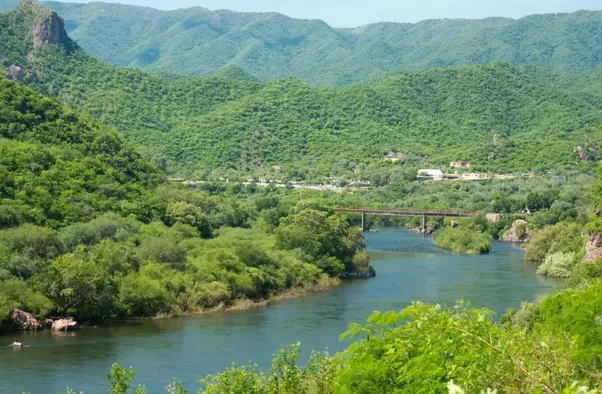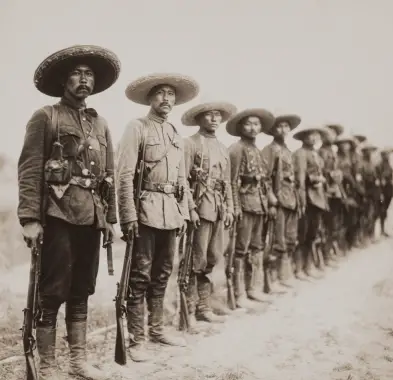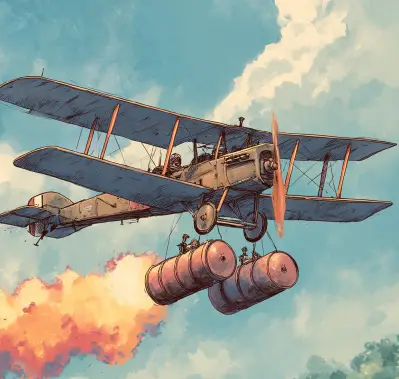Podcast: Play in new window | Download
Subscribe: Apple Podcasts | RSS
 In the arid expanse of Sonora, Mexico, where the Río Yaqui snakes through fertile valleys flanked by jagged sierras, a story of unyielding defiance unfolds. The Yaqui people, indigenous guardians of this land for centuries, have long embodied resilience against encroachment. Their history is etched in blood and dust; a chronicle of wars that spanned from the Spanish conquest to the turbulent years following the Mexican Revolution. Yet, one chapter remains shrouded in obscurity even to Mexicans: the Yaqui War of 1925-1926, a fierce uprising that pitted a small but determined band of warriors against the modern machinery of the post-revolutionary Mexican state. This conflict, often eclipsed by the grand narratives of the Mexican Revolution itself, was not merely a skirmish but a desperate stand for autonomy, land, and survival. For those who relish the hidden undercurrents of Mexican history, this war reveals the enduring spirit of a people who refused to fade into the footnotes of progress. The Yaqui War of 1925-1926, sometimes extended in historical accounts to 1927-1929 due to sporadic fighting, marked the final major clash in the long arc of Yaqui resistance.
In the arid expanse of Sonora, Mexico, where the Río Yaqui snakes through fertile valleys flanked by jagged sierras, a story of unyielding defiance unfolds. The Yaqui people, indigenous guardians of this land for centuries, have long embodied resilience against encroachment. Their history is etched in blood and dust; a chronicle of wars that spanned from the Spanish conquest to the turbulent years following the Mexican Revolution. Yet, one chapter remains shrouded in obscurity even to Mexicans: the Yaqui War of 1925-1926, a fierce uprising that pitted a small but determined band of warriors against the modern machinery of the post-revolutionary Mexican state. This conflict, often eclipsed by the grand narratives of the Mexican Revolution itself, was not merely a skirmish but a desperate stand for autonomy, land, and survival. For those who relish the hidden undercurrents of Mexican history, this war reveals the enduring spirit of a people who refused to fade into the footnotes of progress. The Yaqui War of 1925-1926, sometimes extended in historical accounts to 1927-1929 due to sporadic fighting, marked the final major clash in the long arc of Yaqui resistance.
The 1925 conflict erupted amid the fragile peace of post-revolutionary Mexico, where promises of land reform clashed with the realities of political consolidation. To understand this war, one must first journey back through the Yaqui’s storied past, where each rebellion was a thread in a tapestry of resistance woven from sacred soil and ancestral memory. The Yaqui, or Yoeme as they call themselves, are a Uto-Aztecan people whose homeland centers on the eight traditional pueblos along the Río Yaqui in southern Sonora. Their name derives from the river, Hiak Vatwe, meaning “the brother that cuts through the land,” a vital artery that sustains agriculture, fishing, and spiritual life.
From time immemorial, the Yaqui have viewed their territory as a sacred trust, divided into the yo ania (the inhabited world) and the sea ania (the wilderness realm of spirits and ancestors). This worldview, blending Catholic influences from Jesuit missions with pre-Hispanic traditions, fueled their militancy. Deer dances, pascola rituals, and the veneration of the Virgin of Guadalupe were not just cultural expressions but acts of defiance, preserving identity amid assimilation. The Yaqui’s first major resistance came in 1740, when they joined the Pima and Mayo in the Great Rebellion against Spanish overreach. Led by figures like Juan Ignacio Usacamea, they expelled missionaries and seized mines, only to be subdued by superior firepower.
 Independence from Spain in 1821 brought little relief. The new Mexican republic, strapped for revenue, imposed taxes on the Yaqui in 1825, igniting the first post-colonial war. Visionary leader Juan Banderas, inspired by divine apparitions, rallied 2,000 warriors from Yaqui, Mayo, Opata, and Pima tribes under the Guadalupe banner. For seven years, they raided haciendas and challenged federal authority, forcing the relocation of Sonora’s capital from Arizpe to safer ground. Banderas’s execution in 1832 did not end the fight; it galvanized it. The mid-19th century saw cycles of alliance and betrayal. During the Reform War of 1857 to 1861, Yaqui warriors sided with conservatives against liberal encroachments, only to face reprisals. The French Intervention of 1862 to1867 drew them into imperial service, a pragmatic move that bought temporary peace but sowed seeds of distrust. Porfirio Díaz’s regime from 1876 to 1911 transformed sporadic revolts into systematic genocide. Díaz’s vision of “order and progress” demanded the Yaqui Valley’s transformation into a cotton and sugarcane powerhouse, irrigated by foreign capital. Haciendas encroached, railroads bisected sacred lands, and the 1887 Sonora Constitution explicitly excluded “errant tribes” like the Yaqui from citizenship rights.
Independence from Spain in 1821 brought little relief. The new Mexican republic, strapped for revenue, imposed taxes on the Yaqui in 1825, igniting the first post-colonial war. Visionary leader Juan Banderas, inspired by divine apparitions, rallied 2,000 warriors from Yaqui, Mayo, Opata, and Pima tribes under the Guadalupe banner. For seven years, they raided haciendas and challenged federal authority, forcing the relocation of Sonora’s capital from Arizpe to safer ground. Banderas’s execution in 1832 did not end the fight; it galvanized it. The mid-19th century saw cycles of alliance and betrayal. During the Reform War of 1857 to 1861, Yaqui warriors sided with conservatives against liberal encroachments, only to face reprisals. The French Intervention of 1862 to1867 drew them into imperial service, a pragmatic move that bought temporary peace but sowed seeds of distrust. Porfirio Díaz’s regime from 1876 to 1911 transformed sporadic revolts into systematic genocide. Díaz’s vision of “order and progress” demanded the Yaqui Valley’s transformation into a cotton and sugarcane powerhouse, irrigated by foreign capital. Haciendas encroached, railroads bisected sacred lands, and the 1887 Sonora Constitution explicitly excluded “errant tribes” like the Yaqui from citizenship rights.
The charismatic José María Leyva also known as Cajeme rose to power profiled in Mexico Unexplained episode 35 https://youtu.be/Y7aZZbzCB28 Under his leadership the Yaqui built a de facto state: fortified villages, a standing army, and even diplomatic overtures to the U.S. Cajeme’s 1875 uprising unified 4,000 fighters, holding off federal troops until his capture and execution in 1887. His successor, Tetabiate, pioneered guerrilla tactics in the Sierra del Bacatete, a rugged sanctuary of canyons and peaks. The 1897 Peace of Ortiz promised autonomy and repatriation for deported Yaqui, but Díaz reneged, launching the “final solution” against the Yaqui people in 1899. The January 1900 Battle of Mazocoba was a slaughter: 400 Yaqui dead and 800 prisoners shipped to Yucatán henequen plantations as slave labor in the brutal tropical heat.
An estimated 8,000 to 10,000 Yaqui perished in transit or bondage, their bodies fuel for the Porfirian machine. Deportation was ethnic cleansing by design. Families were torn apart; women and children sold for $75 a head, enduring violation, starvation, and disease in the alien world of Yucatán. Survivors escaped, smuggling across the U.S. border to labor in Arizona cotton fields, where they bought guns to sustain the fight. By 1910, the Yaqui population had plummeted from 30,000 to perhaps 15,000, but their spirit endured.
The 1910 Revolution offered redemption. Yaqui warriors, battle-hardened and land-starved, flocked to Francisco I. Madero’s banner, then to Venustiano Carranza and Álvaro Obregón. Obregón, a Sonora native and one-armed general, courted them assiduously. “The Yaqui are the best soldiers in Mexico,” he proclaimed, enlisting thousands in his Constitutionalist army.
 They fought in key battles like Celaya in 1915, turning the tide against Pancho Villa. In gratitude, Obregón promised restitution: 400,000 hectares of communal lands, water rights, and self-governance. Victory in 1917 brought Article 27 of the Constitution, enshrining agrarian reform. Yet, implementation faltered. Obregón’s presidency from 1920 to 1924 saw Yaqui veterans resettled in ejidos or communal farms, but corruption and elite backlash eroded gains. Haciendas, backed by U.S. investors like the Hearst Corporation, reclaimed valleys through legal chicanery. By 1923, Yaqui leaders like Luis Urías Acosta protested encroachments, demanding enforcement of the 1919 Huerta Peace Treaty, which had repatriated survivors and affirmed territorial rights. In 1924, Plutarco Elías Calles, Obregón’s successor, intensified the strain. A fellow Sonoran, Calles prioritized modernization: dams, irrigation canals, and export agriculture. The Río Yaqui’s waters, once Yaqui lifeblood, were diverted to mestizo settlers and foreign agribusiness. Calles’s anti-clerical policies clashed with Yaqui Catholicism, while his suppression of labor unions alienated rural allies. Whispers of rebellion stirred in the pueblos of Vícam and Potam, where elders recounted Porfirian horrors. The spark? The 1923-1924 De la Huerta Rebellion. Adolfo de la Huerta, finance minister turned insurgent, challenged Calles’s nomination of Obregón for a second term. Yaqui fighters, including Delahuertista sympathizers, joined the fray, seeing it as a proxy for land struggles. Although the uprising was crushed, it radicalized the Yaqui. Exiles in Arizona funneled arms across the border, and by late 1925, guerrilla bands under Juan Luis Matius – or Matías – and José María Valenzuela raided haciendas, demanding water and autonomy. These were not random bandits but heirs to Cajeme’s vision, blending indigenous revivalism with revolutionary rhetoric.
They fought in key battles like Celaya in 1915, turning the tide against Pancho Villa. In gratitude, Obregón promised restitution: 400,000 hectares of communal lands, water rights, and self-governance. Victory in 1917 brought Article 27 of the Constitution, enshrining agrarian reform. Yet, implementation faltered. Obregón’s presidency from 1920 to 1924 saw Yaqui veterans resettled in ejidos or communal farms, but corruption and elite backlash eroded gains. Haciendas, backed by U.S. investors like the Hearst Corporation, reclaimed valleys through legal chicanery. By 1923, Yaqui leaders like Luis Urías Acosta protested encroachments, demanding enforcement of the 1919 Huerta Peace Treaty, which had repatriated survivors and affirmed territorial rights. In 1924, Plutarco Elías Calles, Obregón’s successor, intensified the strain. A fellow Sonoran, Calles prioritized modernization: dams, irrigation canals, and export agriculture. The Río Yaqui’s waters, once Yaqui lifeblood, were diverted to mestizo settlers and foreign agribusiness. Calles’s anti-clerical policies clashed with Yaqui Catholicism, while his suppression of labor unions alienated rural allies. Whispers of rebellion stirred in the pueblos of Vícam and Potam, where elders recounted Porfirian horrors. The spark? The 1923-1924 De la Huerta Rebellion. Adolfo de la Huerta, finance minister turned insurgent, challenged Calles’s nomination of Obregón for a second term. Yaqui fighters, including Delahuertista sympathizers, joined the fray, seeing it as a proxy for land struggles. Although the uprising was crushed, it radicalized the Yaqui. Exiles in Arizona funneled arms across the border, and by late 1925, guerrilla bands under Juan Luis Matius – or Matías – and José María Valenzuela raided haciendas, demanding water and autonomy. These were not random bandits but heirs to Cajeme’s vision, blending indigenous revivalism with revolutionary rhetoric.
The war’s formal onset traces to September 1926, though precursors simmered from 1925. On September 1, 1926, Yaqui warriors ambushed a passenger train near Vícam Station, detaining President-elect Obregón himself. The rebels, led by Matius, presented a manifesto: expel the military from Yaqui lands, restore water diversions, and honor communal land titles. Obregón, ever the pragmatist, negotiated a brief truce, releasing prisoners and promising dialogue. But Calles, viewing it as banditry tied to Delahuertista plots, ordered escalation. What began as hit-and-run raids escalated into open revolt. Yaqui forces, numbering 300-500 fighters, with families totaling 2,000, retreated to the Sierra del Bacatete, a 100-mile fortress of thorny scrub, sheer cliffs, and hidden springs. Here, they drew on ancestral knowledge: camouflaged trails, ambush points, and alliances with Seri and Pima holdouts. Women like María Félix, a legendary scout, ferried supplies from Arizona, evading U.S. Rangers who patrolled the border under Pancho Villa-era precedents. The Mexican response was swift and ruthless. Calles mobilized 15,000 troops under General Francisco Manzo, augmented by 800 Yaqui “auxiliaries” who were coerced Yaquis who were promised land for loyalty. This “divide and conquer” echoed Porfirian tactics, pitting kin against kin. Modern warfare debuted: On September 15, 1926, The New York Times reported plans for aerial bombardment and gas attacks, a grim foreshadowing of total war. Curtiss biplanes from Guaymas dropped 500-pound bombs on Bacatete camps, while mustard gas irritants choked ravines. The chemical echoes of World War I came to Yaqui lands courtesy of U.S. surplus sales.
Eyewitness accounts paint visceral horror. Bill Barker, a railroad engineer at Vícam Station, recalled in a 1996 Journal of Arizona History interview: “The mountains shook with explosions. Yaqui women carried wounded on their backs, screaming defiance as planes strafed them. It was like the old Apache wars, but with wings of death.”
Raids on rebel supply lines yielded macabre trophies: severed ears for bounties, reviving Díaz’s $100-per-Indian policy. Civilians suffered too; pueblos like Esperanza were shelled, and 1926 assaults on prisoner trains left 50 dead in rescue attempts. Key battles defined the war’s ferocity. In November 1926, the Skirmish at La Colorada saw 100 Yaqui repel 500 federales, killing 40 with deer-horn knives and smuggled Winchesters.
 By April 1927, the pivotal Battle of Cerro del Gallo unfolded. Manzo’s 3,000-man column encircled the hill, a rooster-shaped outcrop sacred to Yaqui lore. Matius’s 200 defenders held for 48 hours, rolling boulders and sniping from caves. A nighttime bayonet charge broke the lines; 150 Yaqui fell, including Matius’s brother. The commander escaped, but 415 prisoners—214 women, 175 children—were marched to Hermosillo concentration camps.
By April 1927, the pivotal Battle of Cerro del Gallo unfolded. Manzo’s 3,000-man column encircled the hill, a rooster-shaped outcrop sacred to Yaqui lore. Matius’s 200 defenders held for 48 hours, rolling boulders and sniping from caves. A nighttime bayonet charge broke the lines; 150 Yaqui fell, including Matius’s brother. The commander escaped, but 415 prisoners—214 women, 175 children—were marched to Hermosillo concentration camps.
At the heart of the war were leaders like Juan Luis Matius, a 45-year-old farmer-turned-general whose lineage traced to Tetabiate. Matius embodied Yaqui hybridity: a Catholic who invoked Huya Ania – the infinite power – in speeches, he coordinated via smuggled telegrams to Arizona kin. “We fight not for blood, but for the river’s song,” he wrote in a 1926 letter intercepted by federales. Beside him stood José María Valenzuela, the “Eagle of the Sierra,” whose raids disrupted rail lines to Guaymas, starving federal garrisons. Women were pivotal. In Yaqui society, gender roles blurred in crisis; matriarchs like Luisa Romero organized herbal medicine networks and spied in Obregón’s camps. Deportation survivors from Yucatán, scarred by henequen whips, fueled resolve. One, Petronila Colupay, escaped in 1915 and became a lore-keeper, reciting epics of Cajeme around Bacatete campfires. Children, too, contributed—herding mules or signaling with mirrors—learning war as inheritance. The Yaqui’s tactics were masterful asymmetry. Knowing the sierras’ every arroyo, they struck at dusk, vanishing into fog. U.S. border crossings supplied Mausers and dynamite, bartered for cotton labor. Yet, this transnational lifeline drew American ire; 1926 saw U.S. cavalry clashes in Bear Valley, Arizona, capturing 30 raiders. Los Angeles Times headlines vacillated: from “Bloodthirsty Redskins” in 1906 to “Mexico’s Savage War on Yaquis” by 1927, reflecting shifting U.S. sympathy.
The toll of this little-known war was staggering. Official Mexican tallies claimed 500 Yaqui dead, but Yaqui oral histories and U.S. consular reports estimate 1,200 to 1,500, including civilians. Aerial raids killed indiscriminately; a September 1926 bombing of a Bacatete school tent left 30 children buried in rubble. Gas clouds induced blindness and suffocation, with survivors coughing blood for weeks. Federal troops, many Yaqui conscripts, faced desertion courts and 200 Yaquis serving under the Mexican flag were executed for “treason.”
Atrocities mirrored Porfirian savagery. Manzo’s forces razed pueblos, poisoning wells with arsenic. Captured rebels endured “ear bounties,” their mutilated bodies displayed in Hermosillo plazas. Deportations resumed: 1,000 to Baja California plantations, where malaria claimed half. International outcry grew; the League of Nations queried Mexico in 1927, but Calles dismissed it as “Yankee meddling.” For the Yaqui, loss was existential. Families fragmented; sacred sites desecrated. Yet, guerrilla warfare inflicted costs: 800 federal dead, millions in pesos squandered on a “pacification” that fueled Cristero parallels elsewhere.
By October 1927, attrition prevailed. Matius surrendered on October 2, per Manzo’s report to Calles, after a year in the mountains. Scattered holdouts fought until 1929, but the revolt’s core broke at Cerro del Gallo. The 1927 Yaqui Peace Accord granted nominal ejidos and military withdrawal, but enforcement lagged. Obregón’s assassination in 1928 deepened instability, delaying reforms until Lázaro Cárdenas’s 1937 decree, which finally recognized Yaqui autonomy.
The war’s legacy is bittersweet. It decimated the Yaqui, with its population dipping to 10,000, but their core was preserved. Today, 32,000 Yaqui thrive in Sonora, blending tradition with modernity: solar-powered pueblos, eco-tourism, and legal battles over the Río Yaqui’s waters, siphoned by the Independencia Aqueduct. The 2014-2015 “Water War” blockade, halting traffic on Highway 15, echoes 1926 ambushes, earning UN recognition for indigenous rights.
The Yaqui War of 1925 is somewhat of a ghost story: spectral planes over haunted sierras, whispers of revolutionaries in the wind. It underscores Mexico’s paradox: revolutionary ideals betrayed by statist ambition. The Yaqui teach that land is not a commodity but a covenant. As elder Mario Luna declared in 2015, “We are the river’s voice. Silence us, and the desert reclaims all.” Their war was not the end, but a mere verse in an unfinished epic.
REFERENCES
Barker, William B., and Jeanne Williams. “Eyewitness at Vicam Station: Bill Barker Remembers the Yaqui Revolt of 1926.” The Journal of Arizona History 37, no. 4 (1996): 357–368.
